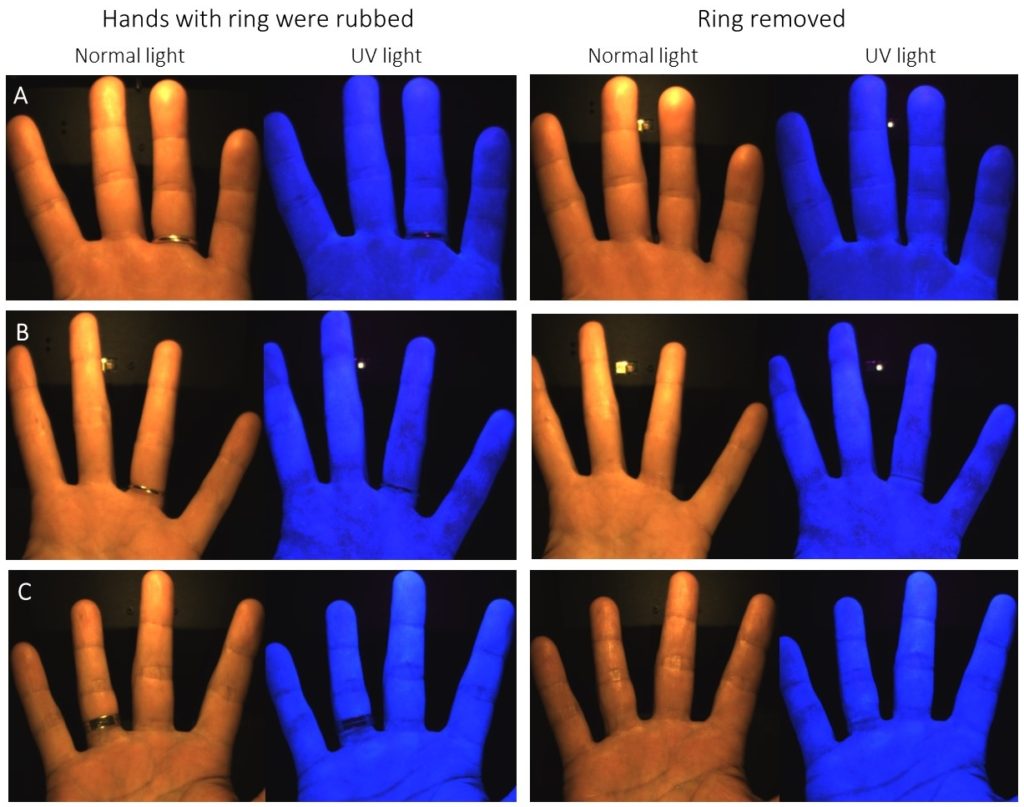The National Evidence-Based Guidelines for Preventing Healthcare-Associated Infections in NHS Hospitals in England clearly says, that healthcare workers (HCW) should remove all wrist and hand jewellery to ensure that their hands can be decontaminated effectively. Their nails should be short, clean and free from artificial nails or nail polish. Now we summarize some studies that confirm the need for these rules.
Rings

- 3% of HCW wearing one or more rings had missed areas on fingers during hand rubbing, compared to 46.3% of those who did not wear any ring [Ramón-Cantón et al. 2011]
- Ring wearing during patient care was found to be a risk factor for hand contamination, and risk was even higher when more than one ring was worn (odds ratio [OR] for one ring: 2.6, OR for >1 ring: 4.6). Wearing rings only at home was not determined as a risk factor [Trick et. al 2003]
- Wearing rings was associated with elevated bacterial colonization after using handrub; both Gram-negative and Gram-positive colonies were significantly higher in numbers [Yildirim et al. 2008]
- Several microorganisms were found on rings, such as Staphylococci (28%), Candida (15%), Aspergillus (13%), coli (11%), Rhodotorula (9%), Klebsiella (7%), Enterobacter (4%), Acinetobacter (4%). Most of the isolates are known to cause nosocomial infections [Khodavaisy et al. 2011]
- Bacterial load was significantly higher (OR 2.63) on ringed hands, and significantly higher number of bacteria were transmitted (OR 2.43) during a simple hand shaking [Fagernes et al. 2009]

There are studies that cannot find correlation between ring wearing and elevated bacterial colonization and transmission. How can it happen that some studies find a strong correlation, while others do not? Figure 1 shows some of our pictures recorded by the Semmelweis Scanner after regular hand rubbing. Sometimes handrub can cover the whole area under the ring (A), sometimes the area under the ring remain untreated (B). In some cases, the area under the ring was covered with handrub, but there was a less treated area in the immediate vicinity of the ring (C), that probably was missed due to ring wearing.
Figure 1: Impact of ring wearing on handrub coverage. Source: HandInScan.
Read more about ring wearing here.
Watch, bracelet

- 90% of those, who wore watch missed some areas during hand disinfection on their wrist, while only 56% of those, who did not wear watch missed any areas. The situation was quite the same for bracelets; there were missed areas on the wrist in 93% of those, who wore bracelet, while 61% of those who did not [Ramón-Cantón et al. 2011]
- Wearing watches and bracelets were both risk factors for poor hand hygiene (odd ratio, OR 2.03 and 1.95, respectively) [Hautemaniere et al. 2010]
- Pathogenic microorganisms were found on hands of 379 laboratory workers who wore jewellery (ring, bracelet or watch), and no one, who wore no jewellery [Alp et al. 2006]
- Significantly greater number of bacteria were isolated under watches compared to the control sites [Field et al. 1996]
- Wearing watches was associated with enhanced total bacterial count; they found more than three times (OR 3.25) as many bacteria on hands with watches compared to control hands [Fagernes and Lingaas 2011]
Read more about wearing watch and bracelet here.
Nails

- Artificial nails are an important risk factor. HCW who wear it are more likely to harbour Gram-negative pathogens [WHO]
- The NHS guideline says that nails must be short, but it is not defined what “short” means exactly. WHO and CDC guideline both say that nails should be shorter than 0.5 cm or ¼ inch.
- Hand were more likely contaminated with Staphylococcus aureus if nails were longer than 2 mm (OR=2.17) [Fagernes et al. 2011]

- Pathogens isolated from HCW’s hands more frequently when they wore artificial nails than in the case of native nails (92% and 62%, respectively). The longer the artificial nails were worn, the more likely a pathogen was isolated [Hedderwick et al. 2000]
- A Klebsiella pneumoniae outbreak investigation in a neonatal intensive care unit (NICU) found that exposure to a HCW who wore artificial nails was associated (odds ratio, OR=7.87) with infection and colonization [Gupta et al. 2004].
- Serratia marcescens bacteremia in a hemodialysis centre was associated with a nurse who wore artificial fingernails upon openingheparin vials [Gordin et al. 2007].
- In a NICU, 10% of neonates acquired Pseudomonas aeruginosa bloodstream infection, and 35% of the infected babies died. During the outbreak investigation, 104 HCW’s hand cultures were examined. Pseudomonas aureginosa was found only on three nurses’ hands, and multivariate logistic regression analysis showed that colonization was associated with two of those three nurses. One of them wore artificial nails, while the other had long natural nails [Moolenaar et al. 2000].
Read more about nails and hand hygiene here
Conclusion
International guidelines (like WHO hand hygiene guideline and CDC hand hygiene guideline) are less strict in regard to wearing jewellery. The NHS Guideline clearly does not recommend wearing any jewellery during patient care. Many studies prove that not wearing a ring, bracelet, watch, artificial- or polished nails during patient care can contribute to improve patient safety. Be compliant with the NHS guideline!
